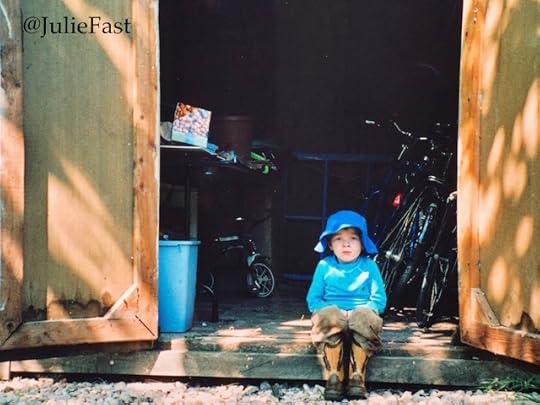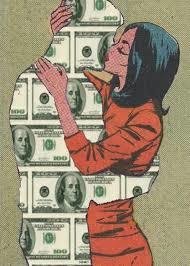Julie A. Fast's Blog, page 21
September 17, 2018
Bipolar, Anxiety and Panic Attacks

Bipolar disorder is about mania and depression mood swings. Within these mood swings, we can have a variety of symptoms including anxiety, attention and focus problems, irritation/anger and more. If you’re depressed and anxious, you’re normal. If you’re in a dysphoric manic episode and are anxious, you’re normal.
Panic attacks are a form of anxiety. A panic attack involves the overall body and mind sensation that there is danger around you and the reaction is one of breathing problems, chest heaviness, fear, the sense that something is wrong and the idea that you can’t go on or function.
Panic attacks are NEVER real. Let me clarify this- they are always about the brain and the body and illness. They are a part of the brain reaction called anxiety. There is no real threat. There is no real problem. If you are actually in danger and have a reaction, this is not anxiety.
What is Anxiety if You are Not Manic or Depressed?
If you have bipolar disorder and have panic attacks when you are NOT manic or depressed, this is a separate anxiety issue. It’s not a part of bipolar. Bipolar symptoms only exist within depression and mania.
I’ve always had anxiety with my bipolar, but everything changed in 2012 when I had a head injury from a biking accident. My regular anxiety- that was always present with my depression turned into a separate and very serious anxiety disorder that included severe panic attacks. I’d experienced a few in the past, but nothing like the daily breathing problems and anxiety I experienced after the accident. Because of this, I had to modify the bipolar disorder management plan I talk about in all of my bipolar and depression books and learn to mange this new and to be honest, REALLY AWFUL anxiety problem.
Help with Panic Attack Symptoms
I was in a panic attack when I started this blog. Writing about anxiety is one way I calm myself down so that I can go back to the work that was adding to my anxiety. I have 12 short articles due for a website. I am excited about the project and LOVE the topic: The Bipolar Disorder Dirty Dozen…twelve substances that can can bipolar disorder mood swings. But every time I sit down to write, the panic shows up. It’s all encompassing. I can’t breath. I have trouble thinking. I worry I will never get the project down. I feel guilt and upset with myself. I feel that the editor will think I’m weak and unprofessional. These are all symptoms of my anxiety panic attacks. I can give in to them and not work or I can learn to work through them, around them and with them.
Here is what I do to manage my panic attacks to get the work done:
Accept that I will not be able to work on a tight deadline. I may have to spread things out in order to manage the anxiety. I HATE this, but it’s my reality. I can fight the reality or work with the brain I have. This means I have to work with websites, publishing companies and editors who understand my work ability.
I breathe. A lot. I focus on breathing. Here is a video that helps me every time.
I’m nice to myself. I love the book The Four Agreements. I started following the ideas of Don Miguel Ruiz over 20 years ago and they have saved me in so many ways. The fourth agreement is DO YOUR BEST. I am doing my best. When I have a panic attack, I must treat anxiety first. There isn’t another path. I can’t write more. I can’t buckle down and meet those deadlines darn it! Nope. I have to stop and treat the anxiety.
I write. Hopefully you can find a process that works for you. For myself, it’s helping others who are going through the same anxiety as I experience. This calms me down. Writing about anxiety reminds me that it’s my brain and not a personal weakness.
I want you to have a good life. I want to have a good life. To do this, we must manage our brains in the same way we manage everything else in life. If you have anxiety, get help. Use the Anxiety Health Card or the system in Take Charge of Bipolar Disorder to write down what you think, say and do when anxious and then come up with a plan to counter the anxiety when it shows up.
We can do this!
Julie
September 16, 2018
9 Facts You Should Know About Psychosis

Julie A. Fast Mild Psychosis 2018
Do people with bipolar get psychotic? Yes, we do!
It’s common for people with bipolar one to get psychotic during full blown mania or a depression. Those of us with bipolar two usually experience psychosis during depression, but we can also get psychotic during dysphoric mania. If you are unfamiliar with these terms, this blog has a search feature you can use for more information. I also write a lot about bipolar disorder in general on the Bp Magazine for Bipolar Website.
The following article from the Health Central website answers the questions, What is Psychosis? What are Hallucinations and Delusions, Can Cannabis Cause Psychosis and more.
I really enjoy writing about this topic. It’s underserved in our bipolar community. I have bipolar disorder and a psychotic disorder. My official diagnosis is schizoaffective disorder. My psychosis started at age 16. I hope you enjoy the article. There is no need to be scared about these words: psychosis, schizo, psychotic. They simply mean that a person has psychosis. A person like myself!
Here is the first section of the article:
What is Psychosis?
“You’re psychotic!” Many people use the words psychotic and psychosis to describe a person’s behavior and yet few understand the very real and quite common symptoms of psychotic experiences and disorders. Psychosis is a break with reality that results from changes in brain chemistry created through illness, substance reactions, or sleep deprivation. The main symptoms of psychosis are hallucinations and delusions.
Click here to read 9 Facts You Should Know About Psychosis.
Please visit me on Facebook to read more about my daily symptoms and how I manage bipolar disorder and my psychosis.
Julie
What is the Difference between Sadness, Grief and Bipolar Depression?

What is the difference between #bipolar #depression and sadness and grief? This is an important distinction as it is one reason that therapy rarely works for bipolar disorder or #schizoaffective disorder unless the therapist is trained in symptom management. ( I love training therapists on bipolar as they can be such an important part of our treatment.)
Sadness and grief are natural human emotions that are attached to a noticeable event. My beloved kitty died last week. I felt and still feel deep sadness and grief. It comes and goes and is directly attached to the loss of my beautiful kitty Bibi. I can pinpoint when and where it started and why. It is not confusing. It is painful, but understandable.
My sadness and grief do not spill over into the rest of my life. For example, I don’t think, my kitty died and now my family members are going to die as well. Life is misery and pain.
That is NOT sadness and grief. That is the language of depression.
Depression takes over the whole person. It takes over all of our thinking. It takes over our behaviors. In can be triggered by an event or come into our lives without one trigger.
This is an enormous difference and a distinction that all health care professionals must make.
Depression is not sadness and grief. Sadness and grief have a timeline. They ease with time. They do not morph into another problem. Watch how stable people deal with sadness and grief. They are normal. I am not normal. I have bipolar depression and it is not about sadness and grief. It is an illness I must treat and manage daily or it will kill me.
When Bibi died, I felt the depression monster climbing up my back. It whispered in my ears that life would always be painful. It talked to me and told me to get in bed and put the covers over my head in order to mourn her. It lied and lied like it always does.
I recognized depression as I have it well listed on my Health Cards.
Before I learned to manage this monster, I was depressed for years and years and years. Every minute was a struggle. I thought of suicide daily. It was not the real me. It was illness.
I want to be ready for the triggers that cause depression. I want to be ready for what life hands me. This means I have to treat bipolar first.
I started my plan in 1998. That is 20 years ago. It took a long time to see results. But I can see them now. My companion died. The grief and sadness were overwhelming at first. I cried as much as I have cried in my life. I felt the pain of loss. And it is getting easier by the day to accept the loss and get on with my life. That is a normal response to loss.
Depression is insidious. It is a as dangerous as any flesh eating bacteria. When the depression tried to take over, I used my plan and said no.
I want the same for you.
We are strong.
Julie
September 11, 2018
Bipolar Disorder and the Loss of a Beloved Pet

My beloved kitty Bibi is gone. I wrote about her cancer diagnosis a few weeks ago. I was ready for her death and want to share with you what I’m doing in order to keep myself stable while going through rather intense grief.
First, thank you for the messages of support. I do a lot of writing on Facebook about my personal life and people have been wonderful. This post is about what I do to keep bipolar under control when I face a big trigger.
Do you have a pet you love? Many of us find such comfort in our wonderful animal companions.
This next question is harder: As a person with bipolar or any mental health disorder, do you have a plan in place for real loss- in other words, are you ready for the death of a beloved pet? Especially if this animal helps with your symptoms? I used to call Bibi my depression companion. What a lovely soul in a beautiful body!
Now she is a soul.
Death of a pet is a bipolar disorder trigger. We need a plan in place for when loss happens. It can be sudden or it can be drawn out as it was with Bibi. We need a plan now that we put into place when the news that a pet is ill or a sudden death happens.
When I heard Bibi had cancer, I had to think of many things outside of my grief. It has been sadly wonderful experience saying goodbye to her. My mom as always was a steadfast companion. I honored Bibi every day that she had left. We all did.
The hardest part of this by far is not knowing how her death might affect my bipolar.
On the day she died, I could not sleep. I found I wanted to write about her in my journal and remember her and cry. All natural behaviors. What was not natural was the fact it was past midnight. At 1 AM, I realized it could be dangerous for my bipolar as I could easily not sleep at all.
I decided I could love her and think of her the next day. I forced myself to sleep.
I took extra sleep meds and got 8 hours. It wasn’t easy, but I did it. I use the goofy SleepwithMe podcast and it helped greatly.
Please think ahead….
What is your plan if your kitty gets sick? What is your plan if your best friend who happens to be a dog, simply gets older as all animals do and his time is near?
I want us to learn how to prepare for triggers so that when they arrive, we know what to do.
Here is a short list of what I did to make Bibi’s death as gentle as possible for my brain.
1. When I realized that my sleep would be affected, I asked my mom to help with her care taking. We were a team in this until the end. I could not stay up at night with Bibi. The guilt was enormous at first, but everyone helped. It also helped that she had a very compassionate vet.
2. I imagined life without her. I thought of what I might feel and opened myself to what might show up in terms of bipolar. Yes, I did this before she died.
3. I had sleep medicines ready and used them. This meant sleeping in for two more hours than usual the day she died. It would be hard to do this if I were at a work place, but I have my own business, so it is possible. If you need this and do work with set hours, take sick time.
4. I decided to fully feel everything, but gave myself a time limit for grief. If I don’t do this, it will spiral into depression. This means I can cry naturally, but I will not let myself cry for five hours straight for example. When the panic attacks showed up, I felt them, did my breathing, talked to myself and worked through them. It’s so much easier to do this when you plan ahead.
5. I told my friends that Bibi was dying and asked for help.
I want to learn from this experience so that when another pet or someone I love dies, I will know what works. I am not doing anything to push down my feelings or have less grief. That is normal.
But I am doing everything I can not to get sick. Depression is knocking on the door. I will not let depression in this hotel!
What is your plan? If it is very painful to think about this, I see that as a positive. It means you will need to plan ahead or the grief might be too much if something happens. Join me on my Julie A. Fast Facebook page for this post and let me know what you need. Ask questions. Let’s all have a plan ready for when a beloved pet leaves our lives.
This leaves us room to remember and celebrate all of the love they brought into the world!
Julie
PS: I saw this gorgeous kitty statue when I was at the British Museum. Yes, it is green and it has earrings.
September 10, 2018
World Suicide Prevention Day and The Brains of Young Children

We can talk with kids about brain health in the same way we talk to them about their little bodies. “The brain creates thoughts and sometimes these thoughts are confusing.”
All brains are capable of suicidal thoughts. It’s part of the human condition. We can stop the increase in suicide by talking with very young children about the brain.
I wrote an article for my Psychology Today blog on the topic called.
3 Strategies to Talk With Kids About Suicidal Thoughts
Here is an excerpt and then the link to the article:
by Julie A. Fast
A few months ago after a intense reaction to a sleep medication, I had the persistent idea I should jump out of my window.
The idea came to me in a wave of images, thoughts and feelings all at once. As though I were watching a movie, I saw myself jump out of the window. I then heard a voice say, “You should jump out of your window.” And finally, I had the intense feeling that everything really would be a lot better if I jumped out of my window.
Luckily, as a person originally diagnosed with bipolar disorder and later a schizoaffective diagnosis, I have over 30 years of living with suicidal thoughts and recognized that I was sick and got help. It was a terrible and scary experience, but I have a mental illness and know it’s simply the way my brain works.
Imagine what it’s like for a child to go through such a suicidal episode where they hear, see and feel the same sensations as adults and yet there is zero life experience to help them through the episode. Just as I taught myself to manage suicidal thoughts, adults can teach very young children to do the same. The goal is shining a light on the symptoms, explaining that they are a normal part of a misfiring brain and then having a plan in place to help the child find stability. We can do all of this while keeping a child safe and nurtured.
Here are the three strategies…
Click here to read the rest of the article on the Psychology Today website. Very young children do have suicidal thoughts. You can use The Health Cards to help with these symptoms and teach a child that suicidal thoughts are normal and we can learn to manage and prevent suicidal thoughts.
Julie
September 9, 2018
Bipolar? Seven Money Saving Tips

I’m doing a series on bipolar and money.. as it is an issue that affects us all!
Ok, here are some tough changes that can save a lot of money. I know, I do them! These are suggestions for those who are truly in financial straights.
1. Cancel cable. Oh yes, it’s hard. But you will read more, get out more and meet more people. If you keep cable, call and say you are thinking of cancelling and would love a special deal.
2. Replace cable with Netflix if you are really into movies.
3. Go cash only- I bring dollar bills with me when I go out. I plan what I’m going to spend before I leave the house. This changed . If you bring a $20, you will spend a $20- especially if you’re depressed or slightly manic.
4. Have a potluck with friends where there is a limit to how much you can spend. $5 is a good amount.
5. Dive less, walk more. It makes a big difference!
6. Call all of your extra expenses including your cell phone company and say, “I may have to cancel my phone, so I would love a deal.” You may be shocked at the savings.
7. Manage bipolar disorder as best you can- less mood swings means more ability to work and make money. Less mood swings means fewer money mistakes. This is especially true with mania. When I started using my Health Cards for mania, my life changed financially for the better. I write about this in Bipolar Happens! as well.
I could do a list of 50 suggestions here, but I guess it’s good to start with seven! I have found that removing expenses is as powerful as making more money.
Julie
September 3, 2018
Why I Take Bipolar Medications

Just got a prescription for Seroquel. I talked with my nurse practitioner Julie Foster of Pohala Clinic – A Place of Healing and we decided that a tiny little bit of the med might help with the next onset of psychosis. Seroquel works. It’s awful in terms of side effects. It makes me hungry and it makes my teeth hurt, but I also have mania and psychosis, so sometimes it is a trade off.
No one really likes psych meds. They have TERRIBLE side effects. But as you might have read from my post a few days ago, I was psychotic and crying simply from enjoying my work. That is not a typo. The work was normal and joyful and my brain decided to react with psychotic paranoia.
I respect #bipolar. It’s a nasty illness. I manage many of my symptoms on my own, but when they get overwhelming I use meds. This means I take meds daily for depression and use meds as needed for mania and depression.
Julie
September 2, 2018
The Bipolar Dirty Dozen
My next project is called The Bipolar Dirty Dozen. I will abbreviate this project as BP-D12. It is a long form article for a website that will come out in the next few months. There will be 12 articles on the substances – the Dirty Dozen – that people with bipolar use regularly, but often with negative results. These include stimulants, steroids, hormones, hallucinogenics, herbs, supplements, amino acids and more. Cannabis will feature regularly.
Here is a poem to get us started.
You know I love poetry.

Julie
August 28, 2018
Can You Tell I’m Psychotic by Looking at my Picture?

Julie A. Fast Mild Psychosis 2018
Do I look ‘normal’ to you? Of course I do. My illness is internal. My face looks fine. I’m not #manic, so my eyes look fine. My skin is ok. My face is a little red due to medications, but overall you would never know that I’m dealing with mild #psychotic #paranoia today.
Everything in my life is going well. Everything. Years of hard work to reach my dreams are finally paying off and I can say that life is good. And yet, I’m sitting here almost crying from the psychosis that simply won’t leave me alone.
My psychosis is usually paranoia.
Paranoia is a delusion. A delusion is a false belief that tells me lies that feel real. That is the best way to describe paranoia. When someone is psychotic with paranoid thoughts, please know that they are not in denial of what is happening. The thoughts and feelings are so real that it is simply a part of living for the person. When you are dressed or manic, there is usually behavior that the outside world can see. There are signs that a person is ill.
Paranoia is silent. It will not show up in our body language or eyes at the beginning. In many ways, we live in our heads and still get on with life so well that people are shocked if the paranoia is actually vocalized.
1. The government has known about chem trails for decades and nothing is being done. We are being poisoned from the sky every day and no one will tell the truth.
When you try to talk rationally to the person, it will NEVER work as the paranoid belief is so strong, it’s unshakable
“Honey, the trails after planes are condensation formations that appear behind all jets depending on the weather and visibility. This can be water or ice crystals.”
You have been brainwashed to think this. Those are chemicals.
2. I can’t keep working at my new office. People are standing in groups making fun of me when I eat lunch. I can hear part of what they are saying and I heard my name few times.
“Honey, could they be wondering if you want to join them? Maybe they want to ask you to have lunch with them, but aren’t sure if you want to be a part of their group?”
Mom, that is what you always say. I know the feeling. It’s just like at my last job. They talk about me. I am different. Smarter. They simply can’t accept this and won’t allow me into their obvious clique.
***
If I don’t treat my paranoia from minute ONE, this is what happens.
My paranoid psychosis is always people related at first. I’m positive and believe me, I mean that I feel this 100% and it’s hard to shake- positive that I am doing something wrong and that I don’t fit it. No matter how often people praise me or include me, my brain tells me that I’m an outsider. This then leads to my being suspicion and looking for clues as to what people really feel. Did they smile at me differently? Did they say hi to others and not me? Who you have paranoia, especially if it’s attached to depression or dysphoric mania, you WILL ruin your relationships.
If the psychosis increases, I start to hallucinate and will see faces where there are no faces and cars following me when there are no cars behind me.
I’m not coaching at this time in order to write a book for couples. My goal is to teach what I have shared with clients for almost a decade. If you have paranoia and want to work, the paranoia must be treated with a program such as The Health Cards or one that works for you. It will not go away on its own.
Cannabis and Paranoia
The worst thing I have experienced in the past few years around my paranoid psychosis is a psychotic episode from the THC in today’s cannabis. If you have psychosis, avoid weed. I will not even use pure CBD as the psychosis still flares. Then, when the psychosis is gone, you can test the cannabis. For myself, my latest trial with hemp based CBD and then flower CBD led to more psychosis.
Take care of yourself. If you love someone who is paranoid, anti psychotic medications work. The side effects are rough, but in terms of being able to function in life, it’s a trade off that many people can accept.
Do you have psychosis? Get help. It’s hard to live with the beliefs paranoia puts in our heads. We need relief.
And one final point. If you have bipolar only, the psychosis will be with mania or depression. If you have psychosis when you are not manic or depressed, this is a separate psychotic disorder and the official diagnosis is schizoaffective.
I have schizoaffective! Here is an article I wrote for the Gum on My Shoe Website on the difference between bipolar and schizoaffective disorder.
Julie
August 24, 2018
How Do I Get Better? #Bipolar #Schizoaffective

Over the past few months, I’ve had more stability in life than in the past few years. What has changed? My decisions. As people with bipolar, it’s our job to be detectives into our lives. What makes us sick.. and just as importantly, what makes us well? I know what makes me sick and I am learning about what makes me well.
Preparation for Stability
1. I had to rid myself of the triggers of bipolar before I could add the good items that increased joy in life. It wasn’t the other way around. There was no room in my life for the positive while I was allowing the negative.
A Huge Change that Led to Stability Many Years Later

Eight years ago I decided to NEVER let #mania take over my life again. It was incredibly hard. It was a big sacrifice and today, I am seeing the benefits. I had to stop dating. It was too dangerous for me as dating and mania went hand in hand. Click here to read Bipolar, Hypersexual, and Celibate: How a dramatic change helped me manage my manic hypersexuality.
2. I left relationships with people who had similar symptoms to mine. This doesn’t make these relationships wrong, nor does it point a finger. I simply can’t be in a relationship with anyone who has paranoia, mania or negative depression. It will come out in the relationship eventually and will make me sick. Who I have in my life 100% affects my moods.
These two changes set me free to say yes to what I wanted in life. Today, I work with stable people who are open to my working needs when it comes to bipolar. They know about all of my symptoms including the paranoia. They also know I’m not going to take these symptoms out on anyone in the work place, but I might have to take a bit of time to myself to deal with the symptoms during stressful times.
Removing the bipolar triggers allowed me to say yes to stable people and a stable working environment. It sounds simple, but it took years. If you start now, you can find the same stability. My bipolar will be back. It always comes back. But the space in between the mood swings is growing. One day? Maybe I will be more stable than ill. We can do this!
I used the picture of the bracelet for a reason. It’s so intricate, but each piece matters. Think of each bead and turn of the leather a change you need to make. Soon, they will add up and you will have a piece or art. Yourself!
Julie
Julie A. Fast's Blog
- Julie A. Fast's profile
- 67 followers



